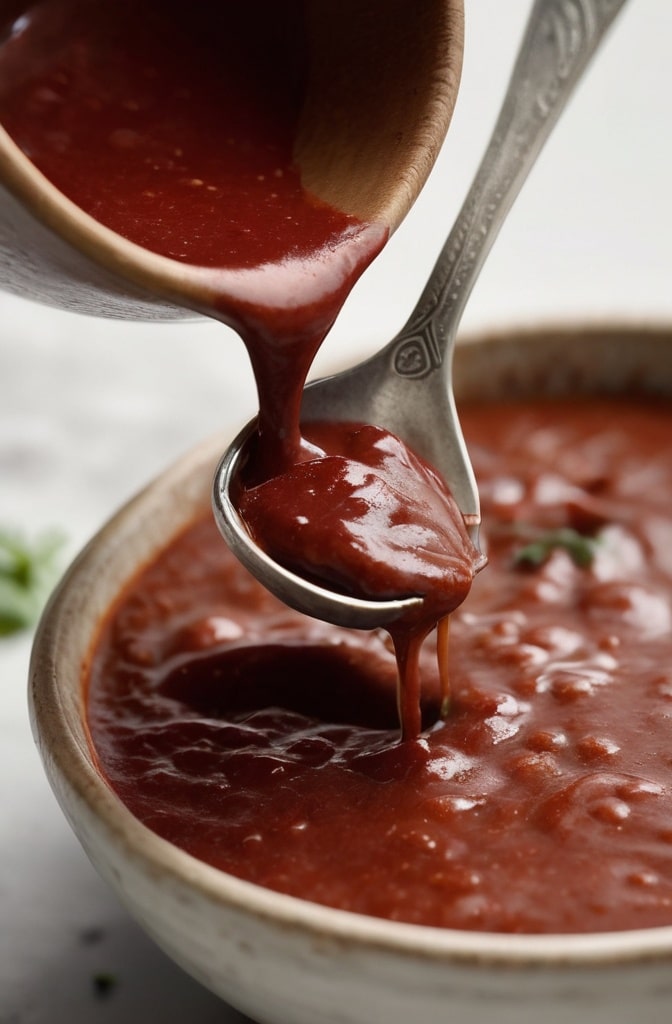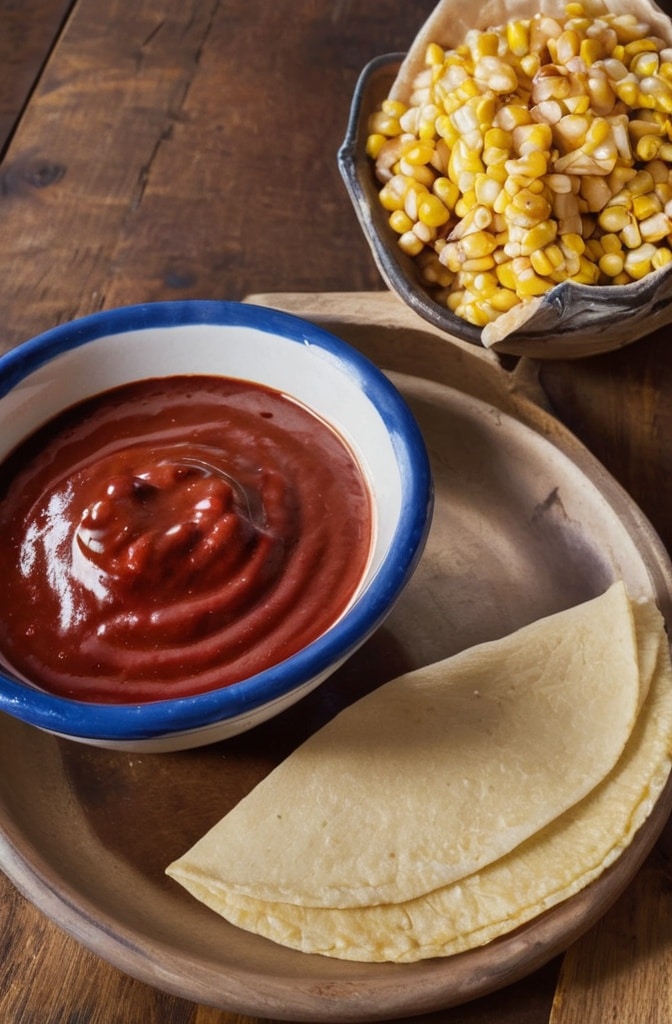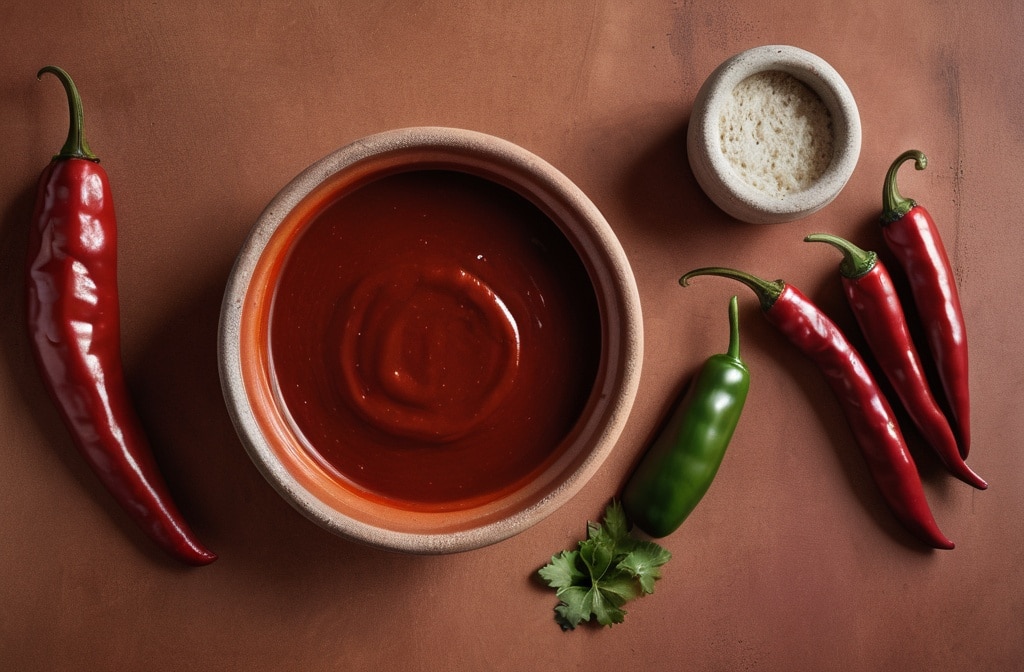Guajillo Sauce, ah—this one takes me back. I was 17, sweating through a summer in Oaxaca, when a señora with kind eyes handed me a small clay bowl. Inside? Fire, earth, and smoke. One spoonful of that deep red sauce and I understood something: this wasn’t just a condiment. It was a whisper of the sunburnt Mexican soil. A history. A story. A wild, silky echo of chile and soul.
Guajillo Sauce is a classic Mexican chilli sauce made primarily from dried guajillo chiles. Smooth. Deeply red. Slightly smoky. With a bit of a tang and a touch of sweetness that teases the back of your tongue. It’s not the burn-your-face-off kind of hot. No, guajillo heat creeps in like a warm blanket. Cozy. Confident. It doesn’t scream, it moulders.
Guajillo Sauce is special ’cause it’s a backbone in Mexican cuisine. Tacos al pastor? Mole rojo? Enchiladas, tamales, even rice—this sauce shows up everywhere, quietly making everything better. Its unique depth comes from the chile itself, sun-dried mirasol peppers turned into guajillos. And that’s just the beginning.
Ingredients & Substitutions
Guajillo Sauce starts with dried guajillo chiles. You want the ones that are pliable, not brittle. They should bend like old leather. If they crack like autumn leaves, chuck ‘em.
- 6–8 dried guajillo chiles (seeds removed)
- 2–3 dried ancho chiles (optional, for depth and smokiness)
- 3 cloves garlic (roasted or fresh—roasted gives a mellow, nutty vibe)
- 1/4 small white onion
- 1 tablespoon tomato paste (adds umami, that sneaky magic)
- 1 teaspoon apple cider vinegar or lime juice (for that bright acidic lift)
- 1/2 teaspoon cumin (toasted, if you’re fancy)
- Salt, to taste
- About 1 to 1½ cups chicken or veggie broth (depends on the thickness you like)
Substitutions: Can’t find guajillos? Try pasilla or New Mexico chiles. They’re not quite the same, but they still got that mellow fire. No tomato paste? A small roasted tomato will work. Or skip it. You do you, as long as you got the chiles right.
Ingredient insights: Always toast the chiles. Even just 30 seconds per side in a dry skillet—do not skip this. It wakes ’em up. Like coffee for dried peppers. Raw guajillos taste like cardboard. Toasted? Hello, flavour bomb.

Step-by-Step Instructions
Guajillo Sauce begins with the chile prep. No shortcuts here, chef.
Step 1: Clean and toast your chiles. Remove stems and shake out most of the seeds. Then, in a dry skillet over medium heat, toast each chile for 20–30 seconds per side. Don’t burn ‘em. Burned chiles taste bitter as regret.
Step 2: Soak ’em. Place toasted chiles in a bowl. Cover with boiling water. Let ’em sit for 15–20 mins. They should get soft like wet velvet. If they’re still tough, soak longer.
Step 3: Blend it all. Drain the chiles (keep some soaking water, just in case). Toss ’em in a blender with garlic, onion, tomato paste, cumin, vinegar, salt, and broth. Blend till smooth. Real smooth. Like bisque, not chunky salsa.
Step 4: Cook it down. Pour sauce into a saucepan with a drizzle of oil. Simmer on low for 10–15 mins. Stir now and then. It’ll thicken slightly and deepen in flavor. That’s where the magic happens. Kitchen starts to smell like a smoky dream.
Expert tip: If the blender gets stuck, add more broth or a splash of soaking water. If it’s gritty, strain the sauce. Or don’t. Rustic can be sexy, too.
Variations: For a spicier kick, toss in a dried árbol chile. For richness, add a bit of Mexican chocolate or a toasted tortilla while blending. For more tang, a splash of orange juice. Yeah, orange. Trust me.
Cooking Techniques & Science
Guajillo Sauce toasts the chiles for a reason. It’s not just to show off. Toasting triggers the Maillard reaction—browning that builds deep flavor. It releases essential oils in the chile skin, coaxing out earthy, fruity notes. Raw chiles just ain’t got that depth.
Guajillo Sauce relies on rehydration, too. When dried chiles soak, their cellulose structure softens, releasing flavour molecules into the liquid. That’s why you can reuse soaking water—it’s steeped like tea.
Guajillo Sauce needs good blending. High-speed blenders like Vitamix or Blendtec create smoother sauces. You want silky, not sandy. A fine mesh strainer can help, but pro chefs just blend till the blades are screaming.
Tools matter: Use a heavy-bottom saucepan when reducing. Thin pans scorch the sauce. Also, wooden spoons > metal spoons. Metal can react with acid and mess with flavor. Plus, wood feels nice in your hand. Simple joy.

Serving & Pairing Suggestions
Guajillo Sauce is a shape-shifter. Serve it over grilled chicken or pork. Spoon it onto tacos. Mix it into enchiladas. Brush it on shrimp skewers before grilling. It even wakes up a plate of scrambled eggs.
Guajillo Sauce plays well with sides. Think: cilantro rice, black beans, charred corn. Even simple warm tortillas can become an event when dipped.
Guajillo Sauce and drink pairings? Oh yeah. Try smoky mezcal cocktails. Cold Mexican lagers. Horchata if you’re keeping it non-alcoholic—its sweet creaminess cools the heat just right.
Presentation tips: Drizzle it like art across your plate. Or go rustic—serve in a clay bowl with a wooden spoon. A sprinkle of queso fresco or a few curls of pickled onion on top doesn’t hurt.
Conclusion
Guajillo Sauce is not just a sauce. It’s a storyteller. A translator of old Mexican kitchens. A bridge between ancient flavours and modern dishes. It teaches patience. Respect for ingredients. And that deep flavour doesn’t need to shout.
Guajillo Sauce rewards technique. Toasting, soaking, blending, simmering—it’s a journey. But once you master it? It’s yours forever. You’ll start throwing it on everything, just to see what happens.
Guajillo Sauce is forgiving. Play with it. Punch it up with garlic, mellow it with cream, twist it into marinades or dips. It’ll take whatever direction you go—and make it better.
FAQs
What is the difference between guajillo chiles and other dried chiles?
Guajillo chiles are moderately spicy with a fruity, slightly tangy flavour. They’re milder than chile de árbol but brighter than ancho chiles. They’re essential for balance in sauces, bringing heat without overpowering everything else.
Can I make Guajillo Sauce ahead of time?
Absolutely. It keeps in the fridge for up to a week. It often tastes better the next day. Freeze it for up to 3 months, preferably in small batches so you can thaw just what you need.
My sauce tastes bitter—what went wrong?
Most likely, your chiles got burned while toasting. Burned guajillos are no joke—they ruin the party. Next time, toast on medium heat and turn quickly. Or skip toasting entirely if you’re unsure.
Do I need to strain the sauce?
Depends on your blender and your texture preference. High-end blenders can get it super smooth. If your sauce is gritty, strain it through a mesh sieve. But rustic works too—it’s your kitchen.
Is Guajillo Sauce spicy?
It has a mild to medium heat. Not too fiery. Just enough to warm your lips a little. If you want more heat, add chile de árbol or a fresh jalapeño to the blend. If you want less, remove all the seeds and veins.

Olivia P. is a seasoned food blogger at Tastywink, sharing delicious, easy-to-follow recipes inspired by him passion for home cooking. With years of culinary blogging experience, he brings flavor, creativity, and a personal touch to every dish.
